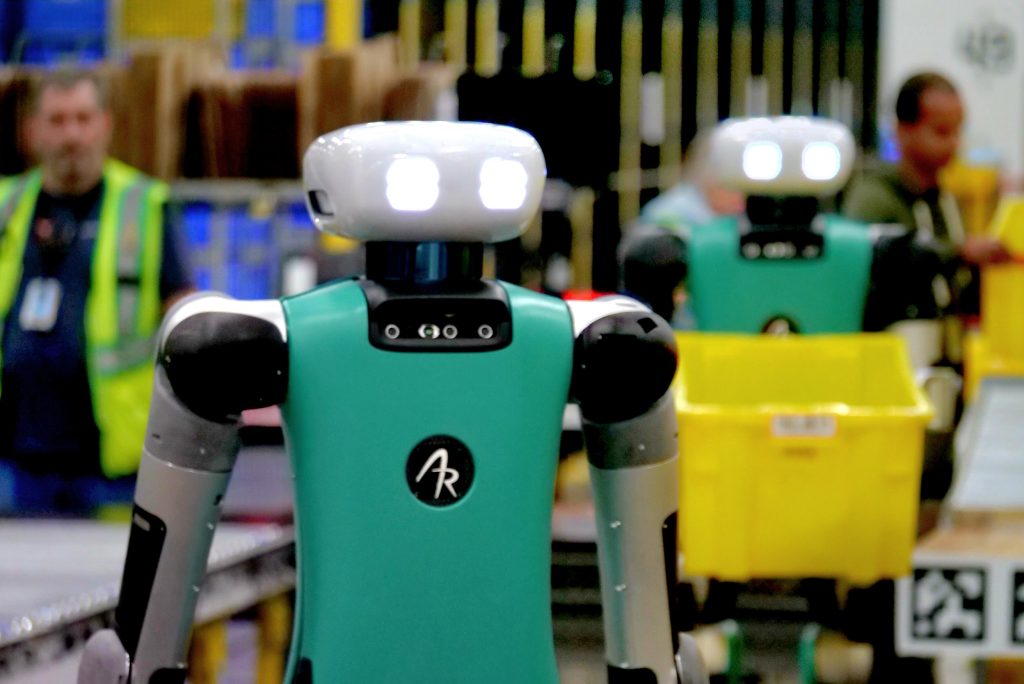Amazon, the global e-commerce giant, has continually revolutionized the logistics and supply chain industry with its innovative approaches. The latest buzz in the industry is Amazon’s ambitious plan to introduce robots to replace human workers in its warehouses. This move has the potential to significantly alter the landscape of warehouse operations, raising questions about efficiency, job security, and the future of human labor in the logistics sector.
Background of Amazon’s Warehouse Operations:
Amazon’s warehouses, known as fulfillment centers, are the heart of its operation, ensuring the swift delivery of millions of products to customers worldwide. Traditionally, these warehouses have been staffed by thousands of workers performing tasks like picking, packing, and shipping orders. However, the challenges of scaling up, along with the need for efficiency and cost reduction, have led Amazon to explore automation.
The Role of Robotics in Warehousing:
The integration of robots into warehouse operations is not entirely new. Automated systems and robots have been gradually incorporated into various logistics processes, from sorting systems to automated guided vehicles (AGVs). These technologies have proven their worth in increasing efficiency, reducing errors, and handling repetitive tasks.
Amazon’s Plan for Robotic Warehouses:
Amazon’s proposal involves a more comprehensive integration of robotics into its warehouse operations. These robots, equipped with advanced sensors, artificial intelligence, and machine learning capabilities, are expected to perform a wide range of tasks, from picking products off shelves to packaging them for shipment. This shift is anticipated to increase the speed and accuracy of order fulfillment significantly.
Impact on Efficiency and Productivity:
The primary advantage of employing robots in warehouses is the substantial improvement in efficiency and productivity. Robots can work continuously without breaks, are not prone to fatigue, and can perform tasks with high precision. This could lead to faster processing times and potentially lower operational costs in the long run.
Concerns and Challenges:
The move towards robotic warehouses is not without its concerns. The most significant is the impact on employment. As robots take over tasks traditionally performed by humans, there is a valid fear of job loss and reduced employment opportunities in the warehousing sector. Furthermore, the initial investment in robotics and the challenge of integrating these systems into existing operations pose significant hurdles.
The Future of Human Workers:
While the introduction of robots may reduce the need for human labor in certain tasks, it doesn’t necessarily spell the end of human involvement in warehouse operations. There will still be a need for human workers to manage, maintain, and oversee the robotic systems. Additionally, this shift could create new job opportunities in robot maintenance, programming, and system management.
Amazon’s plan to introduce robots in its warehouses marks a significant step towards the future of automated logistics. While it promises increased efficiency and productivity, it also brings challenges and concerns, particularly regarding the workforce. As the industry watches this development, it will be crucial to balance technological advancement with the implications for human labor. This initiative by Amazon could set a precedent for how automation is approached in the logistics and supply chain industry.
Ethical and Social Implications:
The introduction of robotics in Amazon’s warehouses also raises important ethical and social questions. The potential displacement of workers by robots is a significant issue, especially in regions where Amazon’s warehouses provide a substantial number of jobs. This move calls for a thoughtful approach to managing the transition, including retraining programs and potential redeployment of affected workers into new roles. There’s also a broader societal debate about the role of automation and AI in the workforce and how economies should adapt to these changes.
Technological Innovation and Its Limitations:
While robots represent cutting-edge technology, they are not without limitations. Current robotic systems, despite their advanced AI and machine learning capabilities, still struggle with tasks requiring fine motor skills or complex decision-making. This limitation underscores the continued need for human intervention in certain aspects of warehouse operations. Amazon’s challenge will be to find the right balance between automated efficiency and human ingenuity.
Global Perspective and Competition:
Amazon’s move could have global implications, influencing how other companies and countries approach warehouse automation. As Amazon sets a new standard, it could spur innovation and competition in the logistics sector worldwide. Companies may feel pressured to adopt similar technologies to remain competitive, potentially accelerating the pace of automation in the industry.
Environmental Considerations:
Another aspect of Amazon’s robotic integration is the environmental impact. Automated systems can be more energy-efficient than human-operated ones, potentially reducing the carbon footprint of warehouse operations. However, the environmental cost of manufacturing, maintaining, and eventually disposing of these robotic systems must also be considered.
Looking Ahead:
As Amazon moves forward with its plans, the eyes of the world will be on the effectiveness and impact of this decision. It represents a significant moment in the evolution of the workforce and the relationship between humans and machines. The success or failure of this initiative will likely influence not just the logistics industry but also the broader discourse on automation and employment in the digital age.
Amazon’s decision to introduce robots in its warehouses is a landmark moment, signifying a shift towards a more automated future in the logistics sector. This move has far-reaching implications, from the efficiency gains and challenges in implementation to the broader ethical, social, and environmental considerations. As we navigate this new landscape, it will be vital to ensure that the benefits of such technological advancements are balanced with the needs and welfare of the workforce and society at large. The future of warehouse operations is poised at an ex
Strategic Implications for Amazon:
For Amazon, the introduction of robots into its warehouses isn’t just about technological advancement; it’s a strategic move. By automating certain processes, Amazon aims to maintain its edge in the highly competitive e-commerce market. This automation could lead to more efficient operations, enabling the company to handle an ever-increasing volume of orders, potentially reducing delivery times and enhancing customer satisfaction. However, this strategy also requires significant investment in technology, training, and system integration, which will be critical factors in determining its success.
Preparing the Workforce for the Future:
A key focus in this transition will be the preparation and upskilling of the workforce. Amazon has the opportunity to lead the way in workforce development, offering training programs that equip employees with the skills needed in an increasingly automated world. This could include technical training in robotics operation and maintenance, as well as in areas like logistics management and data analysis. By investing in its workforce, Amazon can mitigate some of the negative impacts of automation and demonstrate a commitment to its employees’ future.
Regulatory and Policy Considerations:
The shift towards robotic warehouses also brings regulatory considerations into play. Governments and regulatory bodies will need to examine how these changes affect labor laws, safety regulations, and industry standards. There is a growing need for policies that address the challenges posed by automation, such as ensuring fair labor practices and considering the societal impact of displaced workers. Amazon’s initiative may prompt policymakers to rethink regulations surrounding workplace automation.
International Perspective and Market Dynamics:
The implementation of robotics in Amazon’s warehouses is not just a local issue; it has international ramifications. As Amazon operates globally, the adoption of robotic technology in one region could set a precedent for its operations in other countries. This raises questions about the uniformity of technological adoption across different markets, each with its own regulatory landscape and labor market conditions. Additionally, Amazon’s move could influence global supply chain dynamics, setting new operational standards that other international players may follow.
Long-Term Vision and Innovation:
Looking towards the future, Amazon’s foray into robotics is part of a larger vision of innovation and efficiency in the e-commerce space. This move could be a stepping stone towards more advanced technologies such as drone delivery or automated transportation. Amazon’s investment in robotics also signals a commitment to staying at the forefront of technological innovation, potentially driving further advancements in AI and robotics that could have applications beyond warehousing.
In conclusion, Amazon’s plan to integrate robots into its warehouse operations is a multifaceted initiative with wide-ranging implications. While it promises to revolutionize warehouse logistics, it also presents challenges that need to be carefully managed. From workforce implications to global market dynamics and regulatory considerations, Amazon’s move is a significant development in the ongoing dialogue about the role of automation in the modern economy. As we watch this initiative unfold, it will offer valuable insights into the future of work, technology’s role in business, and the evolving landscape of the global logistics industry.






